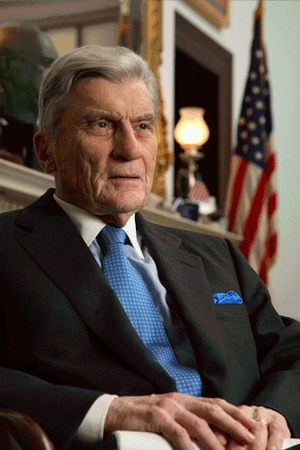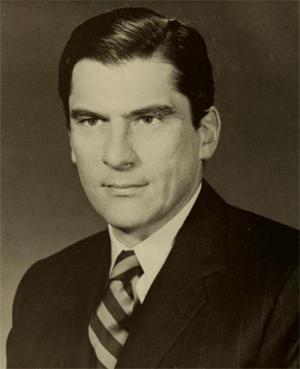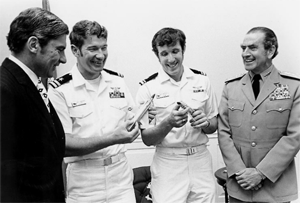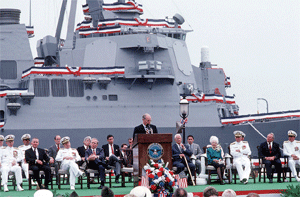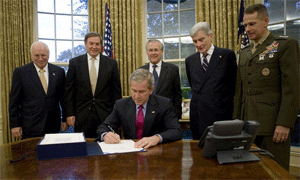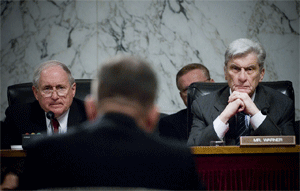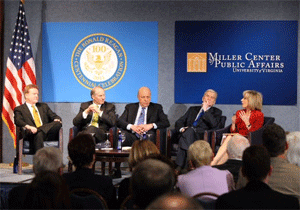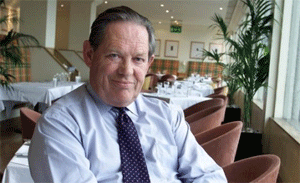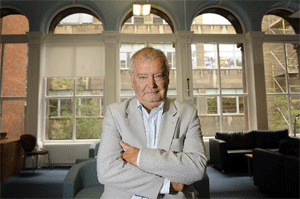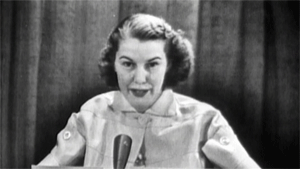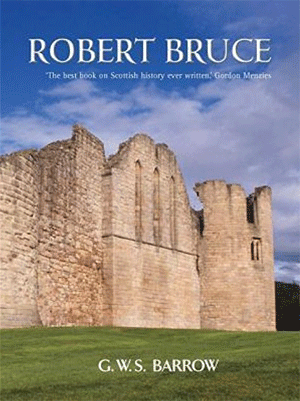by Wikipedia
Accessed: 12/21/17
NOTICE: THIS WORK MAY BE PROTECTED BY COPYRIGHT
YOU ARE REQUIRED TO READ THE COPYRIGHT NOTICE AT THIS LINK BEFORE YOU READ THE FOLLOWING WORK, THAT IS AVAILABLE SOLELY FOR PRIVATE STUDY, SCHOLARSHIP OR RESEARCH PURSUANT TO 17 U.S.C. SECTION 107 AND 108. IN THE EVENT THAT THE LIBRARY DETERMINES THAT UNLAWFUL COPYING OF THIS WORK HAS OCCURRED, THE LIBRARY HAS THE RIGHT TO BLOCK THE I.P. ADDRESS AT WHICH THE UNLAWFUL COPYING APPEARED TO HAVE OCCURRED. THANK YOU FOR RESPECTING THE RIGHTS OF COPYRIGHT OWNERS.
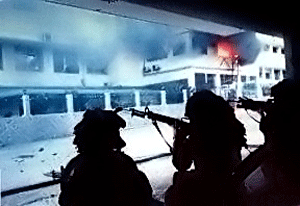
U.S. soldiers prepare to take La Comandancia in the El Chorrillo neighborhood of Panama City, in December 1989.
Date 20 December 1989 – 31 January 1990[1]
(1 month, 1 week and 4 days)
Location Panama
Result US victory[2]
• Military leader Manuel Noriega deposed
Belligerents
Panama
• Panama Defense Force
United States
Panamanian opposition
Commanders and leaders
Manuel Noriega (POW) / George H. W. Bush; Maxwell R. Thurman; Guillermo Endara
Strength
20,000 / 27,000
Casualties and losses
234–314 killed / 26 killed
1,908 captured / 325 wounded
Panamanian civilians killed according to[3]
U.S. military: 202
Americas Watch: 300
United Nations: 500
CODEHUCA: 2,500–3,000
1 Spanish journalist killed[4][5]
The United States Invasion of Panama, code named Operation Just Cause, was an invasion of Panama by the United States between mid-December 1989 and late January 1990. It occurred during the administration of President George H. W. Bush and ten years after the Torrijos–Carter Treaties were ratified to transfer control of the Panama Canal from the U.S. to Panama by 1 January 2000.
During the invasion, de facto Panamanian leader, general, and dictator Manuel Noriega was deposed, president-elect Guillermo Endara sworn into office, and the Panamanian Defense Force dissolved.
Background
The United States had maintained numerous military bases and a substantial garrison throughout the Canal Zoneto protect the American-owned Panama Canal and to maintain American control of this strategically important area. On 7 September 1977, U.S. President Jimmy Carter and the de facto leader of Panama, General Omar Torrijos, signed Torrijos–Carter Treaties, which set in motion the process of handing over the Panama Canal to Panamanian control by the year 2000. Although the canal was destined for Panamanian administration, the military bases remained and one condition of the transfer was that the canal would remain open for American shipping. The U.S. had long-standing relations with General Noriega, who served as a U.S. intelligence asset and paid informant of the Central Intelligence Agency from 1967, including the period when Bush was head of the CIA (1976–77).[6]
Noriega had sided with the U.S. rather than the USSR in Central America, notably in sabotaging the forces of the Sandinista government in Nicaragua, and the revolutionaries of the FMLN group in El Salvador. Noriega received upwards of $100,000 per year from the 1960s until the 1980s, when his salary was increased to $200,000 per year.[7]Although he worked with the Drug Enforcement Administration to restrict illegal drug shipments, he was known to simultaneously accept significant financial support from drug dealers,[6] because he facilitated the laundering of drug money, and through Noriega, they received protection from DEA investigations due to his special relationship with the CIA.[8]
In the mid-1980s, relations between Noriega and the United States began to deteriorate. In 1986, U.S. President Ronald Reagan opened negotiations with General Noriega, requesting that the Panamanian leader step down after he was publicly exposed in The New York Times by Seymour Hersh, and later exposed in the Iran-Contra Scandal.[9] Reagan pressured him with several drug-related indictments in U.S. courts; however, since extradition laws between Panama and the U.S. were weak, Noriega deemed this threat not credible and did not submit to Reagan's demands.[10] In 1988, Elliot Abrams and others in the Pentagon began pushing for a U.S. invasion, but Reagan refused, due to Bush's ties to Noriega through his previous positions in the CIA and the Task Force on Drugs, and their potentially negative impact on Bush's presidential campaign.[11] Later negotiations involved dropping the drug-trafficking indictments. In March 1988, Noriega's forces resisted an attempted coup against the government of Panama. As relations continued to deteriorate, Noriega appeared to shift his Cold War allegiance towards the Soviet bloc, soliciting and receiving military aid from Cuba, Nicaragua, and Libya.[12] American military planners began preparing contingency plans to invade Panama.
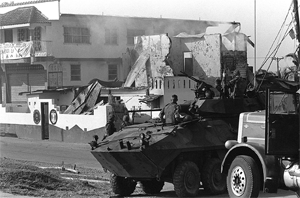
A U.S. Marine Corps LAV-25 in Panama
In May 1989, during the Panamanian national elections, an alliance of parties opposed to the Noriega dictatorship counted results from the country's election precincts, before they were sent to the district centers. Their tally showed their candidate, Guillermo Endara, defeating Carlos Duque, candidate of a pro-Noriega coalition, by nearly 3–1. Endara was beaten up by Noriega supporters the next day in his motorcade.[6] Noriega declared the election null and maintained power by force, making him unpopular among Panamanians. Noriega's government insisted that it had won the presidential election and that irregularities had been on the part of U.S.-backed candidates from opposition parties.[13]Bush called on Noriega to honor the will of the Panamanian people.[6] The United States reinforced its Canal Zone garrison, and increased the tempo of training and other activities intended to put pressure on Noriega.[14]
In October 1989, Noriega foiled a second coup attempt by members of the Panamanian Defense Forces (PDF), led by Major Moisés Giroldi.[15] Pressure mounted on Bush.[6] Bush declared that the U.S. would not negotiate with a drug trafficker and denied knowledge of Noriega's involvement with the drug trade prior to his February 1988 indictment, although Bush had met with Noriega while Director of the CIA and had been the Chair of the Task Force on Drugs while Vice President.[16] On 15 December, the Panamanian general assembly passed a resolution declaring that the actions of the United States had caused a state of war to exist between Panama and the United States.[17][18]
The next day, four U.S. military personnel were stopped at a roadblock around 9:00 PM outside PDF headquarters in the El Chorrillo neighborhood of Panama City. Marine Captain Richard E. Hadded, Navy Lieutenant Michael J. Wilson, Army Captain Barry L. Rainwater, and Marine First Lieutenant Robert Paz had left the Fort Clayton military base and were on their way to have dinner at the Marriott Hotel in downtown Panama City. The U.S. Department of Defense reported that the servicemen had been unarmed, in a private vehicle and that they attempted to flee only after their vehicle was surrounded by an angry crowd of civilians and PDF troops. The PDF asserted later that the Americans were armed and on a reconnaissance mission. The PDF opened fire and Lieutenant Paz was fatally wounded by a round that entered the rear of the vehicle and struck him in the back. Captain Hadded, the driver of the vehicle, was also wounded in the foot. Paz was rushed to Gorgas Army Hospital but died of his wounds. He received the Purple Heart posthumously.[19]According to U.S. military sources, a U.S. Naval officer and his wife witnessed the incident and were detained by Panamanian Defense Force soldiers. While in police custody, they were assaulted by the PDF. The U.S. Naval officer spent two weeks in hospital recovering from the beating. PDF soldiers sexually threatened his wife.[17] The next day, President Bush ordered the execution of the Panama invasion plan; the military set H-Hour as 0100 on 20 December.[20]
United States's justification for the invasion
The official U.S. justification for the invasion was articulated by President George H. W. Bush on the morning of 20 December 1989, a few hours after the start of the operation. Bush listed four reasons for the invasion:[21]
• Safeguarding the lives of U.S. citizens in Panama. In his statement, Bush stated that Noriega had declared that a state of war existed between the U.S. and Panama and that he threatened the lives of the approximately 35,000 U.S. citizens living there. There had been numerous clashes between U.S. and Panamanian forces; one U.S. Marine had been killed a few days earlier.
• Defending democracy and human rights in Panama.
• Combating drug trafficking. Panama had become a center for drug money laundering and a transit point for drug trafficking to the U.S. and Europe.
• Protecting the integrity of the Torrijos–Carter Treaties. Members of Congress and others in the U.S. political establishment claimed that Noriega threatened the neutrality of the Panama Canal and that the U.S. had the right under the treaties to intervene militarily to protect the canal.
U.S. military forces were instructed to begin maneuvers and activities within the restrictions of the Torrijos-Carter Treaties, such as ignoring PDF roadblocks and conducting short-notice "Category Three" military exercises on security-sensitive targets, with the express goal of provoking PDF soldiers. U.S. SOUTHCOM kept a list of abuses against U.S. servicemen and civilians by the PDF while the orders to incite PDF soldiers were in place.[11] As for the Panamanian legislature's declaration of a state of war between the U.S. and Panama, Noriega insists[22] that this statement referred to a state of war directed by the U.S. against Panama, in the form of what he claimed were harsh economic sanctions and constant, provocative military maneuvers (Operations Purple Storm and Sand Flea)[23] that were prohibited by the Torrijos-Carter Treaties. The U.S. had turned a blind eye to Noriega's involvement in drug trafficking since the 1970s. Noriega was then singled out for direct involvement in these drug trafficking operations due to the widespread public knowledge of his involvement in money laundering, drug activities, political murder, and human rights abuses.[9]
Bush's four reasons for the invasion provided sufficient justification to establish bipartisan Congressional approval and support for the invasion. However, the secrecy before initiation, the speed and success of the invasion itself, and U.S. public support for it (80% public approval[citation needed]) did not allow Democrats to object to Bush's decision to use military force.[24] One contemporary study suggests that Bush decided to invade for domestic political reasons, citing scarce strategic reasoning for the U.S. to invade and immediately withdraw without establishing the structure to enforce the interests that Bush used to justify the invasion.[24]
Invasion
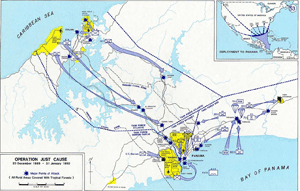
Tactical map of Operation Just Cause showing major points of attack.
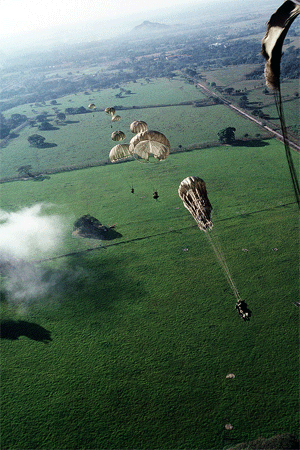
Elements of 1st Bn, 508th Infantry parachuting into a drop zone, during training, outside of Panama City.
The U.S. Army, Air Force, Navy, and Marines participated in Operation Just Cause. Ground forces consisted of :
• combat elements of the XVIII Airborne Corps,
• the 82nd Airborne Division,
• the 7th Infantry Division (Light),
• the 7th Special Forces Group,
• the 75th Ranger Regiment,
• a Joint Special Operations Task Force,
• elements of the 5th Infantry Division
• 1st Battalion, 61st U.S. Infantry and
• 4th Battalion, 6th United States Infantry (replacing 1/61st in September 1989),
• 16th Military Police Brigade (Airborne), Ft Bragg NC
• 503d Military Police Battalion (Airborne), Ft Bragg NC
• 21st Military Police Company (Airborne), Ft Bragg NC
• 65th Military Police Company, Ft Bragg NC
• 108th Military Police Company (Air Assault), Ft Bragg NC
• 519th Military Police Battalion
• 1138th Military Police Company, Missouri Army National Guard
• 988th Military Police Company, Ft Benning, GA
• 193rd Infantry Brigade,
• 5th Battalion, 87th Infantry
• 1st Battalion, 508th
• Marine Security Forces Battalion Panama,
• Kilo company of 3rd Battalion, 6th Marine Regiment,
• Marine Fleet Antiterrorism Security Teams,
• 2nd Light Armored Reconnaissance Battalion,
• 2nd Marine Logistics Group 39th Combat Engineer Btn. Charlie Co.
Air logistic support was provided by the 22nd Air Force with air assets from the 60th, 62nd, and 63rd military airlift wings.
The military incursion into Panama began on 20 December 1989, at 1:00 a.m. local time. The operation involved 27,684 U.S. troops and over 300 aircraft, including C-130 Hercules tactical transports flown by the 317th Tactical Airlift Wing (which was equipped with the Adverse Weather Aerial Delivery System or AWADS) and 314th Tactical Airlift Wing, AC-130 Spectre gunship, OA-37B Dragonfly observation and attack aircraft, C-141 Starlifter and C-5 Galaxy strategic transports, F-117A Nighthawk stealth aircraft flown by the 37th Tactical Fighter Wing, and AH-64 Apache attack helicopters. The invasion of Panama was the first combat deployment for the AH-64, the HMMWV, and the F-117A. Panamanian radar units were jammed by two EF-111As of the 390th ECS, 366th TFW.[25] These aircraft were deployed against the 16,000 members of the PDF.[26]
The operation began with an assault of strategic installations, such as the civilian Punta Paitilla Airport in Panama City and a PDF garrison and airfield at Rio Hato, where Noriega also maintained a residence. U.S. Navy SEALs destroyed Noriega's private jet and a Panamanian gunboat. A Panamanian ambush killed four SEALs and wounded nine. Other military command centers throughout the country were also attacked. The attack on the central headquarters of the PDF (referred to as La Comandancia) touched off several fires, one of which destroyed most of the adjoining and heavily populated El Chorrillo neighborhood in downtown Panama City. During the firefight at the Comandancia, the PDF downed two special operations helicopters and forced one MH-6 Little Bird to crash-land in the Panama Canal.[27] The opening round of attacks in Panama City also included a special operations raid on the Carcel Modelo prison (known as Operation Acid Gambit) to free Kurt Muse, a US citizen convicted of espionage by Noriega.
Fort Amador was secured by elements of the 1st Battalion (Airborne), 508th Parachute Infantry Regiment, and 59th Engineer Company (sappers) in a nighttime air assault which secured the fort in the early hours of 20 December. Fort Amador was a key position because of its relationship to the large oil farms adjacent to the canal, the Bridge of the Americas over the canal, and the Pacific entrance to the Panama Canal. Key command and control elements of the PDF were stationed there. C Company 1st Battalion (Airborne) 508th PIR was assigned the task of securing La Comandancia. Furthermore, Fort Amador had a large U.S. housing district that needed to be secured to prevent the PDF from taking U.S. citizens as hostages. This position also protected the left flank of the attack on La Comandancia and the securing of the El Chorrillos neighbourhood, guarded by Dignity Battalions, Noriega supporters that the U.S. forces sometimes referred to as "Dingbats". Military police units from Ft. Bragg, North Carolina deployed via strategic airlift into Howard Air Force Base the next morning, and secured key government buildings in the downtown area of Panama City. MPs seized PDF weapons, vehicles and supplies during house-to-house searches in the following days, and conducted urban combat operations against snipers and Dignity Battalion holdouts for the following week.
A few hours after the invasion began, Guillermo Endara was sworn in at Fort Clayton.[28] According to The Los Angeles Times, Endara was the "presumed winner" in the presidential election which had been scheduled earlier that year.[29]
A platoon from the 1138th Military Police Company, Missouri Army National Guard, which was on a routine two-week rotation to Panama was called upon to set up a detainee camp on Empire Range to handle the mass of civilian and military detainees. This unit was the first National Guard unit called into active service since the Vietnam War.[30]
Noriega's capture
Operation Nifty Package was an operation launched by Navy SEALs to prevent Noriega's escape. They sank Noriega's boat and destroyed his jet, at a cost of four killed and nine wounded. Military operations continued for several weeks, mainly against military units of the Panamanian army. Noriega remained at large for several days, but realizing he had few options in the face of a massive manhunt and a $1 million reward for his capture, he obtained refuge in the Vatican diplomatic mission in Panama City. The U.S. military's psychological pressure on him and diplomatic pressure on the Vatican mission, however, was relentless, as was the playing of loud rock-and-roll music day and night in a densely populated area.[31] The report of the Office of the Chairman of the Joint Chiefs of Staff maintains that the music was used principally to prevent parabolic microphones from being used to eavesdrop on negotiations, and not as a psychological weapon based around Noriega's supposed loathing of rock music.[27] Noriega finally surrendered to the U.S. military on 3 January 1990. He was immediately put on an MC-130E Combat Talon I aircraft and flown to the U.S.
Casualties

A U.S. Army M113 in Panama
According to official Pentagon figures, 516 Panamanians were killed during the invasion; however, an internal U.S. Army memo estimated the number at 1,000.[32]
The UN estimated 500 deaths[33] whereas Americas Watch found that around 300 civilians died. President Guillermo Endara said that "less than 600 Panamanians" died during the entire invasion. Former Attorney General Ramsey Clark estimated 3,000 civilian deaths. Figures estimating thousands of civilian casualties were widely rejected in Panama. The Roman Catholic Church estimated that 673 Panamanians were killed in total. Physicians for Human Rights, said it had received "reliable reports of more than 100 civilian deaths" that were not included in the US military estimate but also that there was no evidence of several thousand civilian deaths.[34]
Twenty-three U.S. servicemembers were killed[35] and 325 were wounded. But in June 1990, the U.S. military announced that of the casualties, 2 dead and 19 wounded were victims of friendly fire.[36] The U.S. Southern Command, then based on Quarry Heights in Panama, estimated the number of Panamanian military dead at 205, lower than its original estimate of 314.
Civilian fatalities included two American school teachers working in Panama for the Department of Defense Schools. They were Kandi Helin and Ray Dragseth. Rick Paul, the adult son of another teacher, was also killed by friendly fire as he ran an American road block. Also killed was a Spanish freelance press photographer on assignment for El Pais, Juan Antonio Rodriguez Moreno. Rodriguez was killed outside of the Marriott Hotel in Panama City early on December 21. In June 1990, his family filed a claim for wrongful death against the United States Government.[37] When the Rodriguez claim was rejected by the US government, in 1992 the Spanish government sent a Note Verbale extending diplomatic protection to Rodriguez and demanding compensation on behalf of his family.[38][39] However, the US government again rejected the claim, disputing both its liability for warzone deaths in general and whether Rodriguez had been killed by US rather than Panamanian gunfire.[38]
Human Rights Watch's 1991 report on Panama in the post-invasion aftermath stated that even with some uncertainties about the scale of civilian casualties, the figures are "still troublesome" because
[Panama's civilian deaths] reveal that the "surgical operation" by American forces inflicted a toll in civilian lives that was at least four-and-a-half times higher than military casualties in the enemy, and twelve or thirteen times higher than the casualties suffered by U.S. troops. By themselves, these ratios suggest that the rule of proportionality and the duty to minimize harm to civilians, where doing so would not compromise a legitimate military objective, were not faithfully observed by the invading U.S. forces. For us, the controversy over the number of civilian casualties should not obscure the important debate on the manner in which those people died.[40]
Origin of the name "Operation Just Cause"
Operation plans directed against Panama evolved from plans designed to defend the Panama Canal. They became more aggressive as the situation between the two nations deteriorated. The Prayer Book series of plans included rehearsals for a possible clash (Operation Purple Storm) and missions to secure U.S. sites (Operation Bushmaster).
Eventually, these plans became Operation Blue Spoon which was then, in order to sustain the perceived legitimacy of the invasion throughout the operation, renamed by The Pentagon to Operation Just Cause.[41] General Colin Powell said that he liked the name because "even our severest critics would have to utter 'Just Cause' while denouncing us."[42]
The post-invasion civil-military operation designed to stabilize the situation, support the U.S.-installed government, and restore basic services was originally planned as "Operation Blind Logic", but was renamed "Operation Promote Liberty" by the Pentagon on the eve of the invasion.[43]
The original operation, in which U.S. troops were deployed to Panama in early 1989, was called "Operation Nimrod Dancer".[44]
Local and international reactions
The invasion of Panama provoked international outrage. Some countries charged that the U.S. had committed an act of aggression by invading Panama and was trying to conceal a new manifestation of its interventionist policy of force in Latin America. On 29 December, the General Assembly of the United Nations voted 75–20, with 40 abstentions, to condemn the invasion as a flagrant violation of international law.[45]
On 22 December, the Organization of American States passed a resolution deploring the invasion and calling for withdrawal of U.S. troops, as well as a resolution condemning the violation of the diplomatic status of the Nicaraguan Embassy in Panama by U.S. Special Forces who had entered the building.[46] At the UN Security Council, after discussing the issue over several days, a draft resolution demanding the immediate withdrawal of U.S. forces from Panama[47] was vetoed on 23 December by three of the permanent members of the Security Council,[48] France, United Kingdom, and the United States, who cited its right of self-defense of 35,000 Americans present on the Panama Canal.[49]
Peru recalled its ambassador from the U.S. in protest of the invasion.
Some claim that the Panamanian people overwhelmingly supported the invasion.[50] According to a CBS poll, 92% of Panamanian adults supported the U.S. incursion, and 76% wished that U.S. forces had invaded in October during the coup.[50] However, others dispute this finding, asserting that the Panamanian surveys were conducted in wealthy, English-speaking neighborhoods in Panama City, among Panamanians most likely to support U.S. actions.[51] Human Rights Watch described the reaction of the civilian population to the invasion as "generally sympathetic".[52] According to Robert Pastor, a former U.S. national security advisor, 74% of Americans polled approved of the action.[50]
In 2006, one author opined that "President Bush had not defended the hemisphere against European aggression under the guise of the Monroe Doctrine, or used the threat of Communist proliferation to take action, but instead he had used the US military to remove a hostile and problematic Latin American dictator from power because it was in the best interests of the United States to do so."[53]
Eighteen years after the invasion, Panama's National Assembly unanimously declared 20 December 2007 to be a day of national mourning. The resolution was vetoed by President Martin Torrijos.[54][55]
The Washington Post disclosed several rulings of the Office of Legal Counsel, issued shortly before the invasion, in regards to the U.S. armed forces being charged with making an arrest abroad. One ruling interpreted an executive order which prohibits the assassination of foreign leaders as suggesting that accidental killings would be acceptable foreign policy. Another ruling concluded that the Posse Comitatus Act of 1878, which prohibits the armed forces from making arrests without Congressional authorization, is effective only within the boundaries of the U.S., such that the military could be used as a police force abroad—for example, in Panama, to enforce a federal court warrant against Noriega.[56]
Aftermath
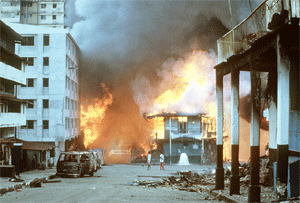
20,000 were displaced from their homes. Disorder continued for nearly two weeks.
Guillermo Endara, in hiding, was sworn in as president by a judge on the night preceding the invasion. In later years, he staged a hunger strike, calling attention to the poverty and homelessness left in the wake of both the Noriega years and the destruction caused by the U.S. invasion.
On 19 July 1990, a group of 60 companies based in Panama filed a lawsuit against the U.S. government in Federal District Court in New York City alleging that the U.S. action against Panama was "done in a tortuous, careless and negligent manner with disregard for the property of innocent Panamanian residents". Most of the businesses had insurance, but the insurers either went bankrupt or refused to pay, claiming that acts of war were not covered.[57]
About 20,000 people lost their homes and became refugees as a result of urban warfare. About 2,700 families that were displaced by the Chorrillo fire were each given $6,500 by the U.S. to build a new house or apartment in selected areas in or near the city. However, numerous problems were reported with the new constructions just two years after the invasion.[58]
The government of Guillermo Endara designated the first anniversary of the U.S. invasion a "national day of reflection". On that day hundreds of Panamanians marked the day with a "black march" through the streets of Panama City to denounce the U.S. invasion and Endara's economic policies. Protesters echoed claims that 3,000 people were killed as a result of U.S. military action. Since Noriega's ousting, Panama has had four presidential elections, with candidates from opposing parties succeeding each other in the Palacio de las Garzas. Panama's press, however, is still subject to numerous restrictions.[59] On 10 February 1990, the Endara government abolished Panama's military and reformed the security apparatus by creating the Panamanian Public Forces. In 1994, a constitutional amendment permanently abolished the military of Panama. Concurrent with a severe recession in Latin America throughout the 1990s, Panama's GDP recovered by 1993, but very high unemployment remained a serious problem.
Noriega was brought to the U.S. to stand trial. He was subsequently convicted on eight counts of drug trafficking, racketeering, and money laundering and sentenced to 40 years in prison. His sentence was later reduced to 30 years.[60]
On December 20, 2015, Vice President Isabel De Saint Malo de Alvarado announced Panama's intention to form a special independent commission with the aim to publish a so-called "truth report" to mark the 26th anniversary of the US attack on Panama. The commission's goal would be to identify victims so that reparations could be paid to their families, as well as to establish public monuments and school curriculums to honor history and reclaim Panama's collective memory. Victims' families have claimed that theretofore investigations into the invasion had been funded by Washington and therefore were biased.[61][62]
Timeline
Information in this section
September 1987
• U.S. Senate passes resolution urging Panama to re-establish a civilian government. Panama protests alleged U.S. violations of the Torrijos–Carter Treaties.
November 1987
• U.S. Senate resolution cuts military and economic aid to Panama. Panamanians adopt resolution restricting U.S. military presence.
February 1988
• Noriega indicted on drug-related charges. U.S. forces begin planning contingency operations in Panama (OPLAN Blue Spoon).
March 1988
• 15 March: First of four deployments of U.S. forces begins providing additional security to U.S. installations.
• 16 March: PDF officers attempt a coup against Noriega.
April 1988
• 5 April: Additional U.S. forces deployed to provide security.
• 9 April: Joint Task Force Panama activated.
May 1989
• 7 May: Civilian elections are held in Panama; opposition alliance tally shows their candidate, Guillermo Endara, beating Noriega's candidate, Carlos Duque, by a 3 to 1 margin. The election is declared invalid two days later by Noriega.
• 11 May: President Bush orders 1,900 additional combat troops to Panama (Operation Nimrod Dancer).[44]
• 22 May: Convoys conducted to assert U.S. freedom of movement. Additional transport units travel from bases in the territorial U.S. to bases in Panama, and back, for this express purpose.
June–September 1989 (Operation Nimrod Dancer)
• U.S. begins conducting joint training and freedom of movement exercises (Operation Sand Flea[44] and Operation Purple Storm[44]). Additional transport units continue repeatedly traveling from bases in the territorial U.S. to bases in Panama, and back, for this express purpose.
October 1989 (Operation Nimrod Dancer)
• 3 October: PDF, loyal to Noriega, defeat second coup attempt.
December 1989
• 15 December: Noriega refers to himself as leader of Panama and declares that the U.S. is in a state of war with Panama.
• 16 December: U.S. Marine lieutenant shot and killed by PDF. Navy lieutenant and wife detained and assaulted by PDF.
• 17 December: NCA directs execution of Operation Just Cause.
• 18 December: Army lieutenant shoots PDF sergeant. Joint Task Force South (JTFSO) advance party deploys. JCS designates D-
Day/H-Hour as 20 December/1:00 a.m.
• 19 December: U.S. forces alerted, marshalled, and launched.
D-Day, 20 December 1989
• U.S. invasion of Panama begins. The operation was conducted as a campaign with limited military objectives. JTFSO objectives in PLAN 90-2 were to: protect U.S. lives and key sites and facilities, capture and deliver Noriega to competent authority, neutralize PDF forces, neutralize PDF command and control, support establishment of a U.S.-recognized government in Panama, and restructure the PDF. Major operations detailed elsewhere continued through 24 December.
• JCS directs execution of Operation Promote Liberty.
3 January 1990 (D-Day + 14)
• Noriega surrenders to U.S. forces.
31 January 1990 (D-Day + 42)
• Operation Just Cause ends.
• Operation Promote Liberty begins.
September 1994 (D-Day + approximately 4.5 years)
• Operation Promote Liberty ends.[43]
Major operations and U.S. units involved
This article needs additional citations for verification. Please help improve this article by adding citations to reliable sources. Unsourced material may be challenged and removed. (December 2016) (Learn how and when to remove this template message)
Operations
All 27 objectives related to the Panamanian Defense Force were completed on D-Day, 20 December 1989. As initial forces moved to new objectives, follow-on forces from the 7th Infantry Division (L) moved into the western areas of Panama and into Panama City.
19 December 1989 (D-Day − 1)
• Company A, 1st Bn, 7th Special Forces Group (Airborne)-already deployed into Panama, along with 3rd Bn, 7th Special Forces Group (Airborne)-then permanently headquartered at Fort Davis, Panama, moved to predetermined positions.
• 3d Bde, 7th Infantry Division (L) (4/17th Inf), already deployed as part of peacekeeping forces in the region, was deployed to predetermined positions.
• 2nd Bde, 7th Inf Div (L), was alerted for deployment. DRF 1 (3/27th Inf) and DRF 2 (2/27th INF) were deployed.
• Tow Platoon, HHC, 5/87th Inf (L), conducts pre-invasion recon of all objectives for Task Force Wildcat.
20 December 1989 (D-Day)
• 3d Bde, 7th Infantry Division (L) (4/17th Inf) began operations in Colon City, the Canal Zone, and Panama City.
• The remainder of the 2d Bde was deployed and closed in Panama.
• Elements of 1st and 3rd Bn, 7th Special Forces Group (Airborne) conducted air assault and secured Pacora River Bridge preventing PDF reinforcements from reaching Omar Torrijos Airport and Panama City.
• The entire 75th Ranger Regiment, split into two elements (Team Black and Team Gold), conducted simultaneous parachute drops at Rio Hato Airfield, along with half the command and control of the HQ 75th RGR, the entire 2nd Battalion 75th RGR, and two companies from 3rd Battalion 75th, to neutralize PDF and Macho de Montes units present, seize the runway, and secure Manuel Noriega's beachside facility.
• The other half of HQ 75th RGR C&C, along with 1st Battalion 75th RGR and the remaining elements of 3rd Battalion 75th RGR, dropped into Omar Torrijos Airport to seize the runway and tower for follow-on operations by elements of the 82nd Airborne Division, deployed by C141 airdrop/airland elements of the 317th Combat Control Squadron, 507th Tactical Air Control Squadron.
• 193d Infantry Brigade (Light) assaulted PDF headquarters at La Commandancia, PDF Engineer Battalion, PDF 5th Company at Fort Amador, PDF units at Balboa and Ancon.
• 45 minutes after the 75th RGR RGT conducted their parachute drop onto Omar Torrijos Airport the 1st BDE 82 ABN DIV begins parachuting onto the airfield, and then assembles for movement to assigned follow on objectives.
21 December 1989 (D-Day + 1)
• JCS directed execution of Operation Promote Liberty (renamed from Plan Blind Logic).
• The Panama Canal reopened for daylight operations.
• Refugee situation became critical.
• C Company, 5th Battalion, 87th Infantry Regiment (193d Infantry Brigade) repelled a PDF counterattack at the PDF DNTT headquarters and rescued Panamanian Vice President Ford, whose convoy was also attacked.
• TF Bayonet began CMO in Panama City.
• Marriott Hotel was secured and hostages evacuated.
22 December 1989 (D-Day + 2)
• FPP established.
• CMO and stability operations became primary focus.
• 2d Bde, 7th Inf Div (L), deployed to Rio Hato.
• 1st Bde (9th Regiment), 7th Inf Div (L), was alerted for deployment.
23 December 1989 (D-Day + 3)
• International airport reopened.
• 2d Bde, 7th Inf Div (L) and SF elements began operations in west.
• 96th CA Bn assumed responsibility for DC Camp from USARSO.
• 1st Bde (9th Regiment) 7th Inf Div (L) closed in Panama.
24 December 1989 (D-Day + 4)
• Noriega entered Papal Nunciatura.
• Money for Weapons program initiated.
• Combined U.S./FPP patrols began.
25 December 1989 (D-Day + 5)
• Rangers secured Davíd.
• Operations in western Panama continued successfully.
3 January 1990 (D-Day + 14)
• Noriega surrendered to U.S. forces.
• Combat and stability ops continue.
31 January 1990 (D-Day + 42)
• Operation Just Cause ends.[63]
• Operation Promote Liberty begins.
September 1994 (D-Day + approximately 4.5 years)
• Operation Promote Liberty ends.[43]
Above information in this section[23]
United States military forces involved in Operation Just Cause[edit]
[x]
U.S. soldiers holding a U.S. flag at La Comandancia
United States Southern Command[64][65]
• United States Army South (USARSO)
• XVIII Airborne Corps – Joint Task Force South
• 525th Military Intelligence Brigade (Combat Electronic Warfare and Intelligence) (Airborne)(FT Bragg)
• 319th Military Intelligence Battalion (Operations) (Airborne) (FT Bragg)
• A Co. 319th MI BN (Corps Tactical Operations Support Element)
• B Co. 319th MI BN (Signal)
• 519th Military Intelligence Battalion (Tactical Exploitation) (Airborne) (FT Bragg)
• A Co 519th MI BN (Interrogation)
• B Co. 519th MI BN (Counterintelligence)
• C Co. 519th MI BN (SIGINT and Voice Intercept)
• 16th MP Brigade Fort Bragg
• 92nd MP Battalion Fort Clayton
•
• 549th MP Company Fort Davis
• 1138th MP Company, Det. 1, Missouri Army National Guard, Doniphan, Missouri
• 1109th Signal Brigade
• 35th Signal Brigade (25th Signal Battalion/426th Signal Battalion) Fort Bragg North Carolina
• 142nd Medical Battalion
• 324th Support Group
• 470th Military Intelligence Brigade
• 747th MI BN, Galeta Island
• 29th MI BN, Fort Davis
• '193rd Infantry Brigade, Task Forces Bayonet
• 1st Battalion (Airborne), 508th Parachute Infantry Regiment (United States)
• 5th Battalion, 87th Infantry
• 4th Battalion, 6th Infantry. Detach from 5th Infantry Division (Mechanized)
• C Company, 3rd Battalion, 73rd Armor Regiment (Airborne), Detach from 82nd ABN Div
• D Company, 2nd Light Armored Infantry Battalion (USMC)
• D Battery, 320th Field Artillery Regiment
• 59th Engineer Company (Sapper)
• 519th Military Police Battalion, Fort Meade, MD
• 209th Military Police Company, Fort Meade, MD
• 555th Military Police Company, Fort Lee, VA
• 988th Military Police Company, Fort Benning Georgia
• 401st Military Police Company, Fort Hood
• 7th Infantry Division (Light), Task Force Atlantic[23]
• A Troop, 2nd Squadron, 9th Cavalry
• 2nd Brigade
• 2nd Battalion, 27th Infantry Regiment (DRF 2)
• 5th Battalion, 21st Infantry Regiment
• 3rd Battalion, 27th Infantry Regiment (DRF 1)
• 6th Battalion, 8th Field Artillery Regiment
• A Battery, 2-62d ADA
• B Company, 27th Engineer Battalion
• B Company, 7th Medical Battalion
• B Company, 707th Maintenance Battalion
• B Company, 7th Supply and Transportation Battalion
• 3rd Brigade
• 4th Battalion, 17th Infantry Regiment
• 3rd Battalion, 17th Infantry Regiment
• C Company, 2d Battalion, 27th Infantry Regiment
• 3rd Battalion, 504th Parachute Infantry Regiment, Detach from 82nd ABN Div
• B Battery, 7th Battalion, 15th Field Artillery Regiment
• B Battery, 2d Battalion, 62nd Air Defense Artillery Regiment
• C Company, 27th Engineer Battalion
• C Company, 7th Medical Battalion
• C Company, 707th Maintenance Battalion
• C Company, 7th Supply & Transportation Battalion
• 3d Platoon, Company B, 127th Signal Battalion
• 127th Signal Battalion (-)
• 27th Engineer Battalion (-)
• 7th Military Police Company (-)
• 107th Military Intelligence Battalion (-)
• 5th Public Affairs Detachment
• 82nd Airborne Division, Task Force Pacific
• 1st Brigade
• 1st Battalion, 504th Parachute Infantry Regiment
• 2d Battalion, 504th Parachute Infantry Regiment
• 4th Battalion, 325th Airborne Infantry Regiment (-)
• A Company, 3d Battalion, 505th Parachute Infantry Regiment
• A Battery, 3d Battalion, 319th Airborne Field Artillery Regiment
• A Battery, 3d Battalion, 4th Air Defense Artillery Regiment
• C Company, 3d Battalion, 73d Armored Regiment (-)
• A Company, 307th Engineer Battalion
• A Company, 782d Maintenance Battalion
• B Company, 307th Medical Battalion
• A Company, 407th Supply & Services Battalion
• A Company, 313th Military Intelligence Battalion
• 1st Brigade, 7th Infantry Division
• 1st Battalion, 9th Infantry Regiment
• 2d Battalion, 9th Infantry Regiment
• 3d Battalion, 9th Infantry Regiment
• A Company, 13th Engineer Battalion
• A Company, 707th Maintenance Battalion
• A Company, 7th Medical Battalion
• A Company, 7th Supply and Transportation Battalion
• 1st Platoon, B Company, 127th Signal Battalion
• Company B, 82d Signal Battalion (-)
• 82d Military Police Company (-)
• 511th Military Police Company, Fort Drum
• Aviation Brigade, 7th Infantry Division, Task Force Aviation
• 1st Battalion, 228th Aviation Regiment
• 195th Air Traffic Control Platoon
• 214th Medical Detachment
• 3rd Battalion, 123d Aviation, Task Force Hawk (Fort Ord)
• E Company, 123d Aviation Regiment (-)
• 1st Battalion, 82d Aviation Regiment, Task Force Wolf (Fort Bragg)
• 1st Battalion, 82d Aviation Regiment (-)
• Troop D, 1st Squadron, 17th Cavalry Regiment
• 1st Battalion, 123d Aviation Regiment (-)
• Company D, 82d Aviation Regiment (-)
United States Marine Corps
• 6th Marine Expeditionary Brigade, Task Force Semper Fi (MARFOR)
• I Company, 3rd Battalion, 6th Marine Regiment
• K Company, 3d Battalion, 6th Marines
• Company D, 2nd Light Armored Infantry Battalion (-)
• G and H Detachment, Brigade Service Support Group 6
• 1st Platoon, Fleet Antiterrorism Security Teams
• Marine Corps Security Guard Detachment (U.S. Embassy)
• Marine Corps Security Force Company Panama
• 534th Military Police Company (U.S. Army), Fort Clayton
• 536th Engineer Battalion (U.S. Army)
United States Special Operations Command
• 7th Special Forces Group
• 160th Special Operations Aviation Regiment (Airborne)
• SEAL Team 4
• SEAL Team 6
• 1st Special Forces Operational Detachment-DELTA
• 75th Ranger Regiment
• 96th Civil Affairs Battalion
• 4th Psychological Operations Group
• 8th Special Operations Squadron
• 16th Special Operations Squadron
• 20th Special Operations Squadron
• 919th Special Operations Wing
• Special Forces 1 (delta force)
United States Air Force
• 24th Composite Wing, Howard AFB
• 317th Tactical Airlift Wing
• 39th Tactical Airlift Squadron
• 40th Tactical Airlift Squadron
• 41st Tactical Airlift Squadron
• 314th Tactical Airlift Wing
• 50th Tactical Airlift Squadron
• 146th Tactical Airlift Wing, California Air National Guard
• 815th Tactical Airlift Squadron
• Twenty-Second Air Force
• 60th Military Airlift Wing
• 62d Military Airlift Wing
• 63d Military Airlift Wing
• 437th Military Airlift Wing
• 433d Military Airlift Wing
• 32d Aeromedical Evacuation Group
• 34th Aeromedical Evacuation Squadron
• 512th Military Airlift Wing
• 172d Military Airlift Wing
• 363d Security Police Squadron
• 3d Mobile Aerial Port Squadron (3d MAPS)
• 366th Tactical Fighter Wing
• 37th Tactical Fighter Wing
• 836th Security Police Squadron
• 63d Security Police Squadron
• 552d Airborne Warning And Control Wing
• 3d Combat Communications Group
• Aerospace Audiovisual Service (AAVS)
• 1352d Combat Camera Squadron, Norton AFB, Calif.
• 1361st Combat Camera Squadron, Charleston AFB, South Carolina
• 1369th Combat Camera Squadron, Vandenberg AFB, Calif.
United States Navy
• United States Navy SEALs
• Naval Special Warfare Unit EIGHT
• Special Boat Unit TWENTY-SIX
• United States Naval Small Craft and Technical Training School (NAVSCIATTS)
• USS Vreeland (FF-1068)
Related operations
• Operation Nifty Package: operation undertaken by SEALs to capture Manuel Noriega or destroy his two escape routes, destroying his private jet at Paitilla Airfield and his gunboat, which was docked in a canal. Noriega surrendered to U.S. troops on 3 January 1990.
• Operation Nimrod Dancer: reinforcing the forward-deployed U.S. forces with a brigade headquarters and an infantry battalion task force from the 7th Inf Div (L), a mechanized infantry battalion from the 5th Inf Div (M), and a U.S. Marine Corps Light Armored Infantry (LAI) Company. Augmentation continued with units rotating from both divisions under Operation Nimrod Sustain.[66]
• Operation Prayer Book
• Operation Promote Liberty: operation to rebuild the Panamanian military and civilian infrastructure.
• Operation Purple Storm: operation to assert, display, and exercise U.S. freedom-of-movement rights, with convoys traveling in and out of Panama for that express purpose.
• Operation Sand Flea: operation to exercise, display, and assert U.S. freedom-of-movement rights, with convoys traveling in and out of Panama for that express purpose.
• Raid at Renacer Prison: a military operation which involved rescuing 64 prisoners and taking over the prison.
See also[edit]
• 1980s portal
• 1990s portal
• The Panama Deception Academy Award winning documentary.
• Invasion, a 2014 Panamanian documentary.
References
Footnotes
1. The National Archives at St. Louis: Veterans Preference and "Wartime" Service
2. "Operation Just Cause: The Invasion of Panama, December 1989". United States Army.
3. "Panama and U.S. Strive To Settle on Death Toll". The New York Times.[full citation needed]
4. "U.S. Sued in Death of a Journalist in Panama". The New York Times. 24 June 1990.[full citation needed]
5. "'It's Been Worth It': Bush—U.S. Troops Take Control of Panama". Los Angeles Times. 21 December 1989.
6. Jones, Howard (2001). Crucible of Power: A History of US Foreign Relations Since 1897. p. 494.[full citation needed]
7. Kempe, Frederick (1990). Divorcing the Dictator. New York: Putnam. pp. 26–30, 162.
8. Cockburn, Alexander & St. Clair, Jeffrey (1998). Whiteout: the CIA, Drugs, and the Press. London: Verso.[page needed]
9. The Contras, Cocaine, and Covert Operations. National Security Archive Electronic Briefing. p. 2.[full citation needed]
10. Buckley, Kevin (1991). Panama: The Whole Story. New York: Simon & Schuster.[page needed]
11. Oakley, Robert B.; Dziedzic, Michael J. & Goldberg, Eliot M. (1998). Policing the New World Disorder: Peace Operations and Public Security. Washington, DC: National Defense University Press.[page needed]
12. Cole, Ronald H. (1995). Operation Just Cause: The Planning and Execution of Joint Operations in Panama, February 1988 – January 1990. Joint History Office, Office of the Joint Chiefs of Staff. p. 6.[full citation needed]
13. A report by the Inter-American Commission on Human Rights concluded that numerous human rights violations occurred in Panama during Noriega's government: "Report on the situation of human rights in Panama". 9 November 1989.[full citation needed]
14. Cole, Ronald H. (1995). Operation Just Cause: The Planning and Execution of Joint Operations in Panama, February 1988 – January 1990. Joint History Office, Office of the Joint Chiefs of Staff. p. 11.[full citation needed]
15. Yates, Lawrence A. (2008). The US Military Intervention in Panama: Origins, Planning and Crises Management, June 1987 – December 1989. Washington, DC: Center of Military History, United States Army.[page needed]
16. "The Noriega Challenge to George Bush's Credibility and the 1989 Invasion of Panama". 2000.[full citation needed]
17. Cole, Ronald H. (1995). Operation Just Cause: The Planning and Execution of Joint Operations in Panama, February 1988 – January 1990. Joint History Office, Office of the Joint Chiefs of Staff. p. 27.[page needed]
18. "On December 15, 1989, Noriega publicly declared that a state of war existed between Panama and the United States." - http://caselaw.findlaw.com/us-11th-circ ... JFMG0.dpuf
19. "Operation Just Cause". 870-5a Organizational History Files (Corps Historian's Notes). XVIII Airborne Corps. 1989–90. Notebook #1. Permanent. Corps Historian's Personal Notes Recorded During the Operation
20. Cole, Ronald H (1995). Operation Just Cause: The Planning and Execution of Joint Operations in Panama, February 1988 – January 1990. Joint History Office, Office of the Joint Chiefs of Staff. p. 30.[page needed]
21. "A Transcript of President Bush's Address on the Decision to Use Force". The New York Times. 21 December 1989.[page needed]
22. Noriega, Manuel & Eisner, Peter (1997). America's Prisoner: The Memoirs of Manuel Noriega. Random House.[page needed]
23. "Operation Just Cause Historical Summary". GS.Org.
24. Cramer, J. K. (2006). "'Just Cause' or Just Politics?: U.S. Panama Invasion and Standardizing Qualitative Tests for Diversionary War". Armed Forces & Society. 32(2): 178–201. doi:10.1177/0095327x05277899.
25. "366th Fighter Wing History". United States Air Force. Archived from the original on 15 June 2011. Retrieved 9 April 2010.
26. Pizzurno, Patricia & Andrés Araúz, Celestino. "Estados Unidos invade Panamá Crónica de una invasión anunciada" (in Spanish). Archived from the original on 21 April 2006.[full citation needed] According to this piece, the PDF had 16,000 troops, but only 3,000 of them were trained for combat: "Para entonces las Fuerzas de Defensa poseían 16.000 efectivos, de los cuales apenas 3.000 estaban entrenados para el combate."
27. Cole, Ronald H. "Operation Just Cause: Panama" (PDF). Joint History Office, Office of the Chairman of the Joint Chiefs of Staff.
28. Fishel, John T. (1997). Civil Military Operations in the New World. Greenwood Publishing Group.[full citation needed]
29. "Combat in Panama, Operation Just Cause}". Los Angeles Times. 21 December 1989. p. A4.
30. http://www.nationalguard.mil/news/today ... ember.aspx[full citation needed]
31. Baker, Russell (3 January 1990). "Observer: Is This Justice Necessary?". The New York Times. Retrieved 9 November 2007.[page needed]
32. Lindsay-Poland, John (2003). Emperors in the Jungle: The Hidden History of the U.S. in Panama. Duke University Press. p. 118. ISBN 0-8223-3098-9.[full citation needed]
33. Pike, John. "Operation Just Cause". Global Security.
34. "Panama and U.S. Strive to Settle on Death Toll". The New York Times.[full citation needed]
35. "US Invasion of Panama 1989". Wars of the World.
36. "'Friendly Fire' Killed 2 GIs in Panama, Invasion: The Pentagon sharply increases its estimate of U.S. casualties inflicted by own forces". Los Angeles Times. Retrieved 12 December 2014.[full citation needed]
37. Riding, Alan (1990-06-24). "U.S. Sued in Death of a Journalist in Panama". New York Times. Retrieved 2015-05-29.
38. Spanish Yearbook of International Law: 1992. 1992. pp. 158–161.
39. "España ha asumido ante el Departamento de Estado de EE UU la defensa de Juantxu". El Pais. 1992-03-27. Retrieved 2015-05-29.
40. "Human Rights in Post-Invasion Panama: Justice Delayed is Justice Denied". 7 April 1991.[full citation needed]
41. Conley, William J., Jr. "Operations 'Just Cause' and 'Promote Liberty': The implications of Military Operations Other than War" (PDF). Small Wars Journal.[full citation needed]
42. Powell, Colin & Persico, Joseph E. (1995). My American Journey. New York: Random House.[page needed]
43. Yates, Lawrence (May–June 2005). "Panama, 1988–1990: The Discontent between Combat and Stability Operations" (PDF). Military Review.[full citation needed]
44. "Operation Nimrod Dancer". Military. Global Security.[full citation needed]
45. "The Responsibility to Protect". International Development Research Centre. December 2001. Archived from the original on 13 December 2007.[full citation needed]
46. Brooke, James (21 December 1989). "U.S. Denounced by Nations Touchy About Intervention". The New York Times.[page needed]
47. United Nations Security Council Draft Resolution S/21048 22 December 1989. Retrieved 13 September 2007.
48. United Nations Security Council Verbatim Report 2902. S/PV/2902 page 15. 23 December 1989. Retrieved 13 September 2007.
49. United Nations Security Council Verbatim Report 2902. S/PV/2902 page 10. 22 December 1989. Retrieved 13 September 2007.
50. Pastor, Robert A. (2001). Exiting the Whirlpool: U.S. Foreign Policy Toward Latin America and the Caribbean. p. 96.
51. Trent, Barbara (Director) (31 July 1992). The Panama Deception (Documentary film). Empowerment Project.
52. "Panama". Human Rights Watch World Report 1989. Human Rights Watch. 1989.[full citation needed]
53. Brewer, Stewart. Borders and Bridges: A History of U.S.–Latin American Relations. p. 147.[full citation needed]
54. "Panama's President Vetoes Law Declaring Anniversary of US Invasion a 'Day of Mourning'". Archived from the original on 13 March 2008. [full citation needed]
55. "Panama Marks '89 Invasion as Day of 'National Mourning'". CNN. Archived from the original on 19 December 2008.
56. Henkin, Louis (1991). Right v. Might: International Law and the Use of Force. pp. 161–2.[full citation needed]
57. "Panama Companies Sue U.S. for Damages". The New York Times. 21 July 1990.[full citation needed]
58. "El Chorrillo Two Years after the U.S. Invaded Panama, Those Displaced by the War Have New Homes". Christian Science Monitor. 20 December 1991.[full citation needed]
59. "Attacks on the Press 2001: Panama". Committee to Protect Journalists.
60. "BOP: FCI Miami". Archived from the original on 16 July 2010. Retrieved 16 July 2010.
61. "Panama to Launch 'Truth Report' on 1989 US Invasion". TeleSUR English. 20 December 2015. Retrieved 31 January 2016.
62. "Truth Report Investigating 1989 US Invasion of Panama Warms Up". TeleSUR English. 26 January 2016. Retrieved 31 January 2016.
63. The National Archives at St. Louis: Veterans Preference and "Wartime" Service
64. "Operation Just Cause: Panama 1989".[full citation needed]
65. http://etd.lsu.edu/docs/available/etd-0 ... ed/AppB(US).pdf[full citation needed]
66. "Operation Just Cause Historical Summary: Operation Just Cause Lessons Learned Volume I".[full citation needed]
Bibliography
• Eisenmann, Roberto (21 December 1989). "For a Panamanian, Hope and Tragedy". The New York Times.
Further reading[edit]
• Donnelly, Thomas (1991). Operation Just Cause: The Storming of Panama. Lexington Books. ISBN 0669249750.
• Harding, Robert C. (2001). Military Foundations of Panamanian Politics. Transaction Publishers. ISBN 978-0-7658-0075-6.
• ——— (2006). The History of Panama. Greenwood Publishing. ISBN 978-0-313-33322-4.
• Phillips, R. Cody (2004). "Operation Just Cause: The Incursion into Panama".
• Yates, Lawrence A. (2008). The U.S. Military Intervention in Panama: Origins, Planning and Crisis Management, June 1987 – December 1989 (1st ed.). Washington, DC: United States Army Center of Military History. CMH Pub 55–1–1.

